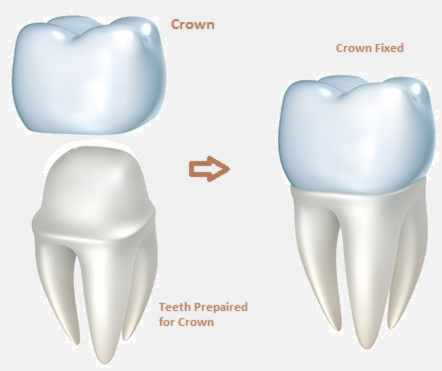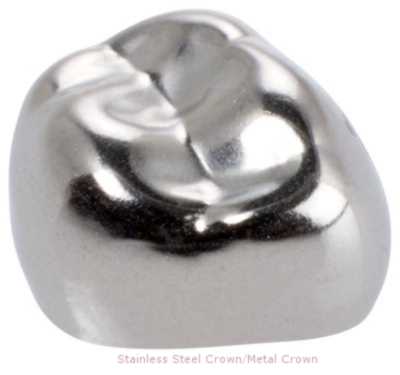 Tooth crown is like a covering or a cap fabricated to embrace the tooth all around and provide protection. It maintains strength, shape, size as well as appearance of the teeth/tooth.
Tooth crown is like a covering or a cap fabricated to embrace the tooth all around and provide protection. It maintains strength, shape, size as well as appearance of the teeth/tooth.
If the tooth is fractured or massively decayed, removing that tooth is not the only solution. Tooth crown may be given if the roots are sound enough.
Crowns are also needed when the tooth is decayed or fractured at the corners. In such cases the defect may be small but fillings are not promising enough because it comes out every now and then due to lateral pressure and consequently micro leakage. Fillings can temporarily give you relief from food lodgement but in long term it may impose risk of further decay.
Also it is mandatory after root canal treatment. We always think why always crown after RCT. Won’t filling suffice? The answer is NO. Because after root canal gets deprived of nerve supply making it brittle like a nail. Any undue pressure may lead to fracture of the tooth. If root canal treated tooth gets fractured, the only solution is to remove it and then your root canal too is a waste.
Tooth crown is also given to enhance looks. Sometimes teeth are discolored or maligned. In such cases we give crowns by adjusting the shape and shade as per adjacent natural teeth and your choice. This helps you to get a beautiful smile without much discomfort.
Sometimes there is food lodgement in between the teeth but there is no decay. The reason is the gaps between the teeth due to gum disease and bone loss. In such cases tooth crown is the only solution to prevent food lodgement and further decay.
Also, mostly root canal treated teeth are either massively deprived of tooth structure or they are decayed along the walls of teeth making them weaker. If tooth crown are not given in such teeth, tendency to fractures increase.
To enhance longevity and strength of root canal treated tooth, crown are very much required.
Though the vice versa is not true. We need not to do root canal to give a tooth crown. There is a generalised notion that root canal is done prior to crown. This is a myth. If tooth is painless and symptom less and the reason of crown is either looks or food lodgement due to decay or pockets, crown ìs possible without RCTs.
Tooth crowns are also given to replace a missing tooth. In such cases the teeth adjacent to the missing tooth/teeth are covered with crowns to replace the missing tooth. This whole unit with caps on the adjacent teeth slong with the replaced missing tooth is called bridge.
Crowns are also given over implants once the implants get fused with the underlying bone. These are replacement of missing tooth by the means of implants.
Tooth crowns are either Permanent or Temporary.
Temporary crowns are made of acrylic and given in the interim duration by the time permanent caps are fixed. Mostly temporary crowns are needed in case of implants. Implants take 3-4 months to fuse with the bone. In that duration we can not give permanent crowns. If patient is not willing to stay without teeth in that duration, temporary crown is given.
Also when the crowns are to be given in front teeth region temporary crowns are given by the time permanent ones are fabricated. This won’t hamper your looks in that interim duration.
Permanent crowns are of various types
- Metal
- Porcelain fused to metal/Metal Ceramic
- Ceramic
- Stainless Steel
Metal Crown
Made of metallic alloys such as cobalt chromium or nickel chromium.
They are strong enough to withstand chewing pressure. The do not wear and are corrosion resistant. These are noble metals which do not reach in external environment. Also they do not pose any harm on human body.
The only disadvantage is its metallic show. They are visible as a metal in mouth. Earlier gold crowns were very popular but now a days they are less prevalent because of the appearance.
Porcelain fused to metal
These are made in two layers. Underneath there is metal to give strength. Over it a porcelain based ceramic layer is given to enhance looks. The shade of this layer is matched with the adjacent teeth to give natural appearance. This makes the differentiation between the natural and artificial crown difficult.
The disadvantage is that sometimes there is a blackish hue visible along the neck of the tooth where the margin of cap lies. It is usually not visible initially but happens over the period of time. Mostly it is a point of concern in front teeth region if you are very much concerned about the looks. This is due to the undelying metal which gives the blackish hue.
In cases of back teeth region this is usually not a problem because that area is not visible in back teeth. Also strength is more important in those teeth because they are subjected to chewing forces.
It is durable and most common amongst all being cost effective as well as aesthetic.
Ceramic Crown
These are made up of porcelain like material in total. The lower layer known as coping is also made up of ceramic. It also matches the shade of teeth thus creating no blackish hue. This is its biggest advantage. It gives very natural appearance and you can’t even figure out which one is your artificial tooth. Even after years it gives no hue or unsightly apperance.
It is preferred mostly in front teeth region where looks are more important than strength. In terms of strength it is inferior to the metal ones. Metal is more stronger than ceramics. It is costlier than metal or porcelain fused to metal. Zirconia, 3m lava, dicor all fall in this category.
Stainless Steel Crowns
 These are usually prefabricated ones which are used in children i.e milk teeth. These are preferred when massive decay is there and filling comes out every now and then. Then stainless steel crowns help in preservation of tooth. When the tooth sheds crown comes out own its own along with. These do not need multiple sittings and can be fixed with minor adjustments. Sometimes it is also given as temporary crowns by the time permanent cap is fixed. Though it is very rare that these are used.
These are usually prefabricated ones which are used in children i.e milk teeth. These are preferred when massive decay is there and filling comes out every now and then. Then stainless steel crowns help in preservation of tooth. When the tooth sheds crown comes out own its own along with. These do not need multiple sittings and can be fixed with minor adjustments. Sometimes it is also given as temporary crowns by the time permanent cap is fixed. Though it is very rare that these are used.
Procedure of giving a tooth crown
- Tooth preparation
- Crown cementation
Tooth preparation for crown
It implies the alterations and shaping of the tooth to make room for the crowns . Before we start with the tooth preparation, Xrays are done to make sure that the roots and the surrounding bone is free of infection. If there is decay in the tooth X rays are more important to know if it is approaching the nerve tissues known as pulp or not.
If the decay is away from the pulp and tooth is symptomless, root canal is not required. If there is any trace of infection or pain is present, root canal is done prior to crown fabrication. If tooth is decayed filling is done and then tooth is grinded 1-2 mm to make the space for cap.
The grinding of tooth is done all around and from the top. Amount of tooth removed depends on the type of cap given. Metal cap and ceramic caps need lesser space whereas metal ceramic caps need comparitively more space. Once required space is created impressions of your teeth are made. These record negative replica of your prepared teeth.
Crowns are not made by the dentist. We send these impressions to the respective labs and they are fabricated. 2 days to week time is needed in their making depending on the type of crown chosen and technique of manufacturing used. Usually the procedure is not painful but if pain or sensations are felt, anaesthesia is given to make you comfortable.
Crown Cementation
Once the crown is made it is fixed over the tooth by the means of dental cements. Cement act as a glue to keep the cap fixed for years. This also varies according to the type of cap. Ceramic caps are preferably fixed by resin cements while metallic or metal ceramic caps can be fixed by glass ionomer cements. Minor alterations like adjusting your bite is done before cementing crowns so that you feel no difference. This is completely painless procedure.
Usually caps once fixed won’t come out but if it ever does, same cap is fixed with the cement after minor or no alteration. Only you should get that fixed in a day or two.
Temporary Crowns
If needed, these are fabricated either in the clinic itself. It takes 15-20 minutes. Else it is sent to lab and fabricated in a day or 4-5 hours. These are cemented with temporary cements so that they can be removed easily. Mostly they are made from acrylic based materials.These don’t have much strength and are only for looks.
Life span of crowns varies from 10-15 years depending on your age , hygiene maintenance and general health. Even after that cap remains as it is, but gap is created along the margins and in between the teeth due to recession of gums. This leads to food lodgement and decay if not taken care of.
No special care or brushing techniue or toothpaste is needed after u get a crown done. Important is the way of brushing and use of floss or inter dental brushes if required.
Time to time follow up say every 6-8 months is helpful in detection of any problem and its timely treatment.
Crowns are painless procedure which prevent your tooth from fracturing. Thus it only increases the life of your anyways compromised tooth. Also due to advances in dentistry now such caps are available which can’t be distinguished from your natural teeth.

